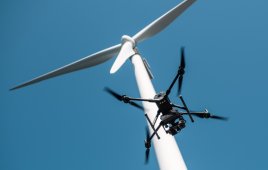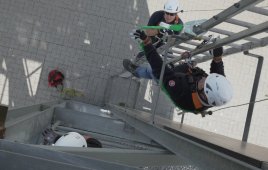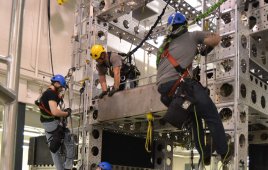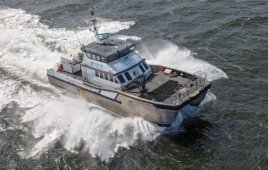Compared to long-established industries such as oil and gas, windpower is a young venture. Many of its leaders, however, come from more mature fields. In their new wind-industry roles, they’ve brought with them – to varying degrees – safety-first work processes. The incident reporting funnel, for example, which brings accidents experienced in the field to the attention of management, seems to be well-greased. Still, a funnel doesn’t guard workers from injury or equipment from damage.
As entrepreneurial workers left behind oilrigs and shipyards, they stepped into an industry that, while advancing technologically, was stuck in the past when it came to safety. They saw a growing tally of incidents including dropped tools, the injury or loss of colleagues, and government insistence on safe work. As a result, safety cultures emerged, albeit varied in rigor.
“I have seen the gamut of safety cultures,” says Mike Kelley, director of environmental safety and health at UpWind Solutions. Kelley joined the company seven years ago, bringing with him two decades of safety experience. “In wind, we’re not 100% of the way there, but we’re on our way.”
Indeed, the windpower industry – from its trade organization to individual technicians – is centering attention on building cultures of safety. Some of the tools required: Data, training, and honesty.
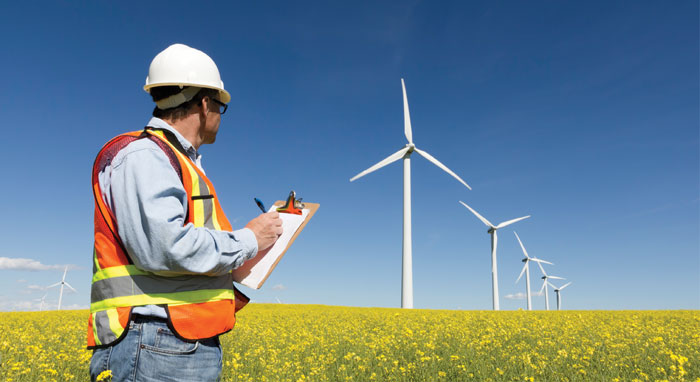
According to AWEA, data shows it’s possible overall accidents in the industry have increased, while also cautioning that fact alone does not mean it has a poor safety record. The industry has been growing rapidly, and the total amount of wind generating capacity in the U.S. today is roughly 24 times what it was at the end of the year 2000.
Gathering data
The American Wind Energy Association (AWEA) created a safety committee in 2008, now known as the Environmental Safety and Health Committee, in recognition that these issues are important for a thriving industry.
“That set the foundation in place for building a better safety culture within the wind industry,” says Michele Myers Mihelic, director of worker health and safety policy and standards development at AWEA. “That’s not to say there wasn’t a safety culture beforehand. Each company had its own. Creating this committee helps mold these cultures together.”
While having a safety committee that produces items such as white papers and guidelines is useful, specific data on accidents could improve safety messaging and rebut windpower critics who make claims that the industry is unsafe. Recognizing this, AWEA tasked itself with gathering actionable data, and is now collecting basic industry safety statistics from a relatively small group of companies. The data reflects what is collected on OSHA Form 300 – details such as how many employees a company has, how many hours were worked, lost-time cases, and deaths.
According to AWEA, the data shows it’s possible overall accidents in the industry have increased, while also cautioning that fact alone does not mean it has a poor safety record. The industry has been growing rapidly, and the total amount of wind generating capacity in the U.S. today is roughly 24 times what it was at the end of the year 2000. But AWEA is looking to develop better, more nuanced statistics.
“When you take a look at broad data from a relatively small number of companies, it’s hard to identify exactly where windpower is experiencing problems,” Mihelic says.
To help industries identify safety issues, the Bureau of Labor Statistics (BLS) collects workplace accident data under classification codes identifying specific jobs from road paver to airline pilot. However, most wind-industry workers have found themselves classified under “other” codes in industries such as manufacturing, construction, and transportation, meaning windpower-specific statictics are lost in a mass of indistinct data.
There is one exception: In 2012 the government announced a code for “wind generation,” though its narrow definition will exclude many workers, and information obtained under that code won’t be available until 2016 at the earliest.
Mihelic emphasizes a need for further specification. She says the wind industry can be divided into four basic areas: manufacturing, construction, operations and maintenance, and miscellaneous, which includes transportation and specialty contractors. AWEA is attempting to gets BLS codes for these specific jobs and, eventually, aggregate the data. The result, says Mihelic, will be safer work environments.
“Once you have this information, it pushes companies to do better,” she says. “Nobody wants to look at the average incidence rate and be below it. It pushes everyone to have a better safety record, culture, policy, programs, diligence, and training.”
Climbing upward
The U.S. wind industry didn’t just take off in the 2000s, it exploded. Manufacturers and developers, building turbines daily, scrambled to find technicians to maintain equipment they had never before seen or touched. It’s common to say the industry recruited “cowboys.”
Shane McDaniel, now a technical service director at ZF Corp., had returned from Iraq in 2008 and found himself without a job. The market had bottomed out in Ohio, his home state. McDaniel says a friend who was climbing turbines in Oklahoma said he could get him a job.
Indeed, all McDaniel had to do was prove to managers at a windpower company (not ZF Corp.) that he could climb a turbine, unafraid of heights, and then he got an interview. Many technicians have similar stories.
Since then, however, technical and community colleges have developed curriculum offering students training for successful and safe work up-tower. Many campuses, to lure students, advertise full-scale turbine replicas, where they can learn safe practices and rescue strategies.
“When you get an influx of employees from training colleges, they already know that, if they want to get home at night, there is more to climbing turbines than just doing the work,” McDaniel says.
While technicians may be coming to the job with greater skill and appreciation for safety, McDaniel laments there is no common certification for safety training.
ZF Corp. constructs gearboxes that the company services and warranties in turbines from a variety of manufactures, and every manufacturer and turbine owner has diverse safety policies, usually based on the industry in which the company got its start.
“It’s sometimes challenging for my wind technicians to go to sites involving multiple customers and turbine manufacturers and satisfy the different safety requirements,” says McDaniel.
Mike Kelley from UpWind Solutions agrees that navigating a variety of policies is difficult, though he says a design standard could be more appropriate. He offered the example of boat-building.
“If we were manufacturing boats in Europe, we would have to meet certain design standards – from the U.S. Coast Guard and others – before we could bring the boat to the U.S. and sell it. The same is true for automobiles or airplanes,” he says. “For wind turbines, there is no design standard.”
While there are various design criteria wind companies must meet from organizations such as OSHA, ANSI and others, there is no governing body that reviews designs of a wind turbine.
The main ingredient for safety
While the industry works toward national standards and sufficient reporting, each company is responsible for its own safety protocols. UpWind Solutions prides itself on working toward “zero harm,” a company goal originating at its founding seven years ago.
When the company started, Kelley asked the CEO: “Will UpWind be a company that encourages reporting – honest and forthright – and one that reports all accidents to OSHA?”
The answer has been “yes,” Kelley says. Of course, the reporting of every incident is dependent on a single human quality: Honesty. It can be a challenging ethos to cultivate among employees because, in some work cultures, honesty leads to discipline or termination.
“Some safety managers walk tall and carry a big stick, and that scares everybody,” Kelley says. “Technicians do what they’re told to do because they’re afraid of the repercussions if they do not. But once that person has left, they go back to doing whatever they want to do, however they want to do it. That culture isn’t sustainable. We’re not policemen. We’re there to advocate.”
McDaniel from ZF Corp. says a method he uses for obtaining honest feedback from employees is to counsel groups after an incident – not individuals. “I don’t want to say you don’t hold people accountable, but you have to get people to the table for an open, honest discussion,” he says. “After shaping policy, after establishing a pipeline, you have a standard to which you hold individuals accountable.” WPE
Three programs one company uses to promote safety
UpWind Solutions has devised three programs to support a culture of safety. Each program was rolled out with copious discussion and plenty of time for employees to grasp it. Importantly, managers continue to talk about the programs on a regular basis.
![]() Zero Harm: Employeess sign a commitment to doing their job and not causing harm to themselves, their partners, the equipment they work with, or the equipment they’re working on. Getting buy-in for such a program requires repeated exposure, says Mike Kelley, Director of Environmental Safety and Health at UpWind Solutions. The company printed stickers, which were pasted to work computers, trucks, and tool boxes.
Zero Harm: Employeess sign a commitment to doing their job and not causing harm to themselves, their partners, the equipment they work with, or the equipment they’re working on. Getting buy-in for such a program requires repeated exposure, says Mike Kelley, Director of Environmental Safety and Health at UpWind Solutions. The company printed stickers, which were pasted to work computers, trucks, and tool boxes.
“We sent banners to every job site and every office. We told the site managers, ‘When you get your banner, hang it up in the work room and have employees sign their name on it,’” Kelley says. Even the CEO signs the banners when he goes to a field office or site.
![]() I Can Stop Work At Any Time: This program lets any employee stop a job when they feel something is wrong and get an answer to a question without repercussion.
I Can Stop Work At Any Time: This program lets any employee stop a job when they feel something is wrong and get an answer to a question without repercussion.
A year and a half ago, Kelley says, during a single-blade changeout with the rotor intact, a tower rocked back and forth a little bit. It bothered a technician, who called a stand down. An EHS manager went to the job site. All parties agreed why it had happened: Studs were stuck due to rust. When they broke lose, the tower shook.
It cost a day’s production, says Kelley, but it was the right thing to do.
![]() Safe Start: “We started seeing small, sometimes inconsequential accidents,” says Kelley. This program addresses those by promoting personal safety.
Safe Start: “We started seeing small, sometimes inconsequential accidents,” says Kelley. This program addresses those by promoting personal safety.
In one example, a technician used a pocket knife to cut a box open. He returned the knife to his pocket, and the blade came open. Later, he shoved his hand into the pocket and the blade went through the center of his hand.
“It’s a recordable, on-the-job injury because it happened at work, but really, it was personal injury. It was something he did to himself,” Kelley says.
“We’re not 100% there, but I believe safety culture in a nutshell is everyone – from management down to the people in the field – taking personal responsibility for their own safety and those around them,” he says.
Filed Under: Safety

